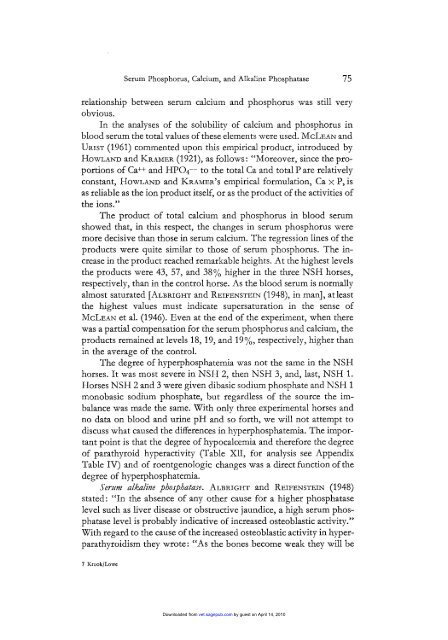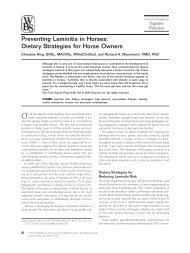Nutritional Secondary Hyperparathyroidism in the Horse
Nutritional Secondary Hyperparathyroidism in the Horse
Nutritional Secondary Hyperparathyroidism in the Horse
You also want an ePaper? Increase the reach of your titles
YUMPU automatically turns print PDFs into web optimized ePapers that Google loves.
Serum Phosphorus, Calcium, and Alkal<strong>in</strong>e Phosphatase 75<br />
relationship between serum calcium and phosphorus was still very<br />
obvious.<br />
In <strong>the</strong> analyses of <strong>the</strong> solubility of calcium and phosphorus <strong>in</strong><br />
blood serum <strong>the</strong> total values of <strong>the</strong>se elements were used. MCLEAN and<br />
URIST (1 961) commented upon this empirical product, <strong>in</strong>troduced by<br />
HOWLAND and KRAMER (1921), as follows: “Moreover, s<strong>in</strong>ce <strong>the</strong> proportions<br />
of Ca++ and HP04-- to <strong>the</strong> total Ca and total P are relatively<br />
constant, HOWLAND and KRAMER’S empirical formulation, Ca x P, is<br />
as reliable as <strong>the</strong> ion product itself, or as <strong>the</strong> product of <strong>the</strong> activities of<br />
<strong>the</strong> ions.”<br />
The product of total calcium and phosphorus <strong>in</strong> blood serum<br />
showed that, <strong>in</strong> this respect, <strong>the</strong> changes <strong>in</strong> serum phosphorus were<br />
more decisive than those <strong>in</strong> serum calcium. The regression l<strong>in</strong>es of <strong>the</strong><br />
products were quite similar to those of serum phosphorus. The <strong>in</strong>crease<br />
<strong>in</strong> <strong>the</strong> product reached remarkable heights. At <strong>the</strong> highest levels<br />
<strong>the</strong> products were 43, 57, and 38% higher <strong>in</strong> <strong>the</strong> three NSH horses,<br />
respectively, than <strong>in</strong> <strong>the</strong> control horse. As <strong>the</strong> blood serum is normally<br />
almost saturated [ALBRIGHT and REIFENSTEIN (1948), <strong>in</strong> man], at least<br />
<strong>the</strong> highest values must <strong>in</strong>dicate supersaturation <strong>in</strong> <strong>the</strong> sense of<br />
MCLEAN et al. (1946). Even at <strong>the</strong> end of <strong>the</strong> experiment, when <strong>the</strong>re<br />
was a partial compensation for <strong>the</strong> serum phosphorus and calcium, <strong>the</strong><br />
products rema<strong>in</strong>ed at levels 18, 19, and 19 yo, respectively, higher than<br />
<strong>in</strong> <strong>the</strong> average of <strong>the</strong> control.<br />
The degree of hyperphosphatemia was not <strong>the</strong> same <strong>in</strong> <strong>the</strong> NSH<br />
horses. It was most severe <strong>in</strong> NSH 2, <strong>the</strong>n NSH 3, and, last, NSH 1.<br />
<strong>Horse</strong>s NSH 2 and 3 were given dibasic sodium phosphate and NSH 1<br />
monobasic sodium phosphate, but regardless of <strong>the</strong> source <strong>the</strong> imbalance<br />
was made <strong>the</strong> same. With only three experimental horses and<br />
no data on blood and ur<strong>in</strong>e pH and so forth, we will not attempt to<br />
discuss what caused <strong>the</strong> differences <strong>in</strong> hyperphosphatemia. The important<br />
po<strong>in</strong>t is that <strong>the</strong> degree of hypocalcemia and <strong>the</strong>refore <strong>the</strong> degree<br />
of parathyroid hyperactivity (Table XlI, for analysis see Appendix<br />
Table IV) and of roentgenologic changes was a direct function of <strong>the</strong><br />
degree of hyperphosphatemia.<br />
Serum alkal<strong>in</strong>e phosphatase. ALBRIGHT and REIFENSTEIN (1948)<br />
stated: “In <strong>the</strong> absence of any o<strong>the</strong>r cause for a higher phosphatase<br />
level such as liver disease or obstructive jaundice, a high serum phosphatase<br />
level is probably <strong>in</strong>dicative of <strong>in</strong>creased osteoblastic activity.”<br />
With regard to <strong>the</strong> cause of <strong>the</strong> <strong>in</strong>creased osteoblastic activity <strong>in</strong> hyperparathyroidism<br />
<strong>the</strong>y wrote: “As <strong>the</strong> bones become weak <strong>the</strong>y will be<br />
7 Krook/Lowe<br />
Downloaded from<br />
vet.sagepub.com by guest on April 14, 2010



